Racism and Education: A Comprehensive Analysis of Anti-Racism Efforts
VerifiedAdded on 2023/04/11
|9
|2578
|250
Essay
AI Summary
This essay explores the pervasive issue of racism within the educational system, examining the theoretical underpinnings of racism and the development of anti-racist responses. It begins by defining racism and anti-racism, then delves into sociological theories such as functionalism and symbolic interactionism to explain the roots of racial discrimination. The discussion focuses on the manifestations of racism in educational institutions, highlighting how factors like wealth, background, and institutional biases contribute to discriminatory practices. The essay cites historical examples and personal experiences to illustrate the detrimental effects of racism on students, including depression and the reinforcement of negative stereotypes. Furthermore, it discusses anti-racist measures implemented by governments and institutions, such as legislative actions and awareness programs, and concludes with a reflection on personal experiences of discrimination in educational settings, emphasizing the need for ongoing efforts to combat racism and promote equality.
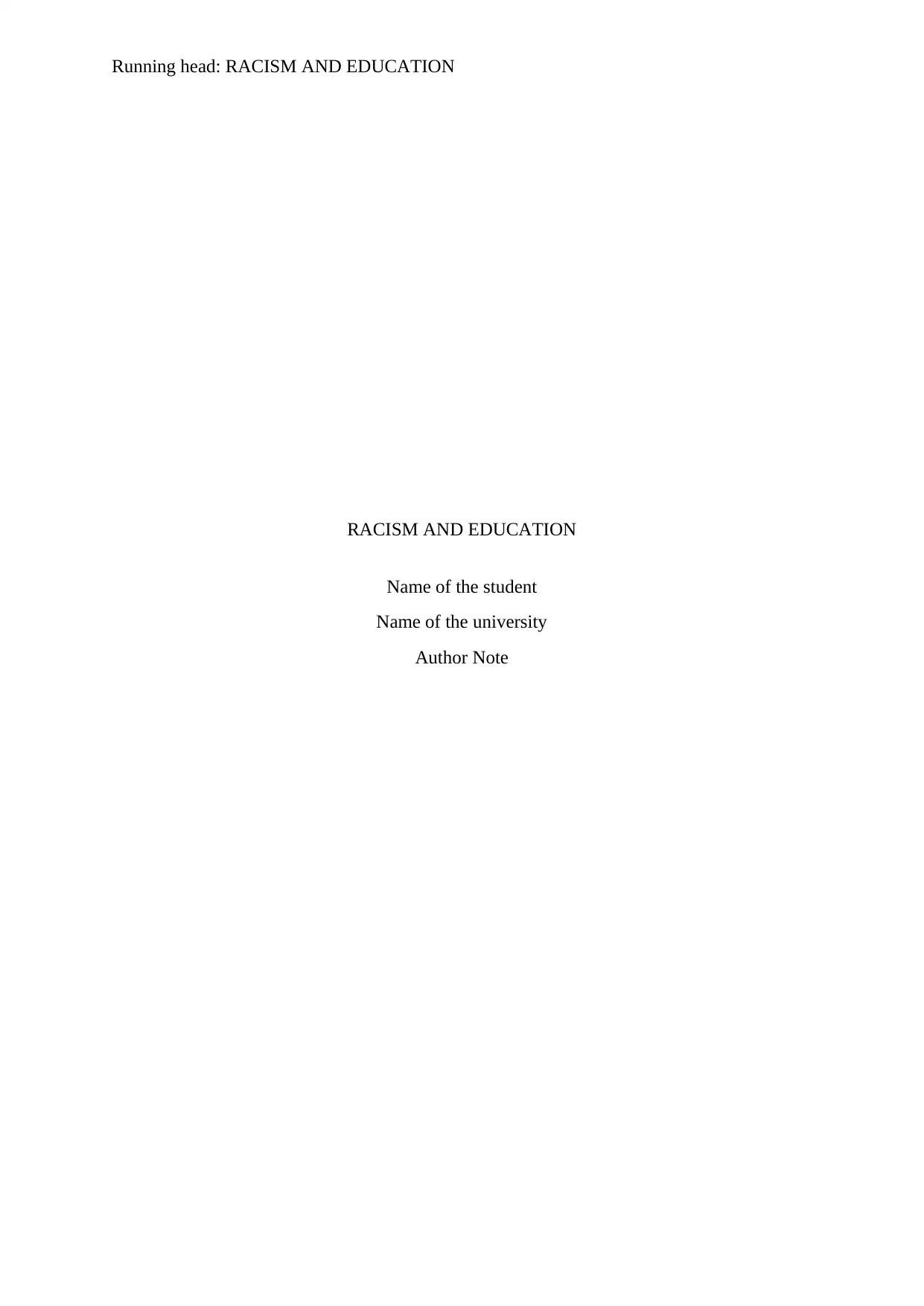
Running head: RACISM AND EDUCATION
RACISM AND EDUCATION
Name of the student
Name of the university
Author Note
RACISM AND EDUCATION
Name of the student
Name of the university
Author Note
Paraphrase This Document
Need a fresh take? Get an instant paraphrase of this document with our AI Paraphraser
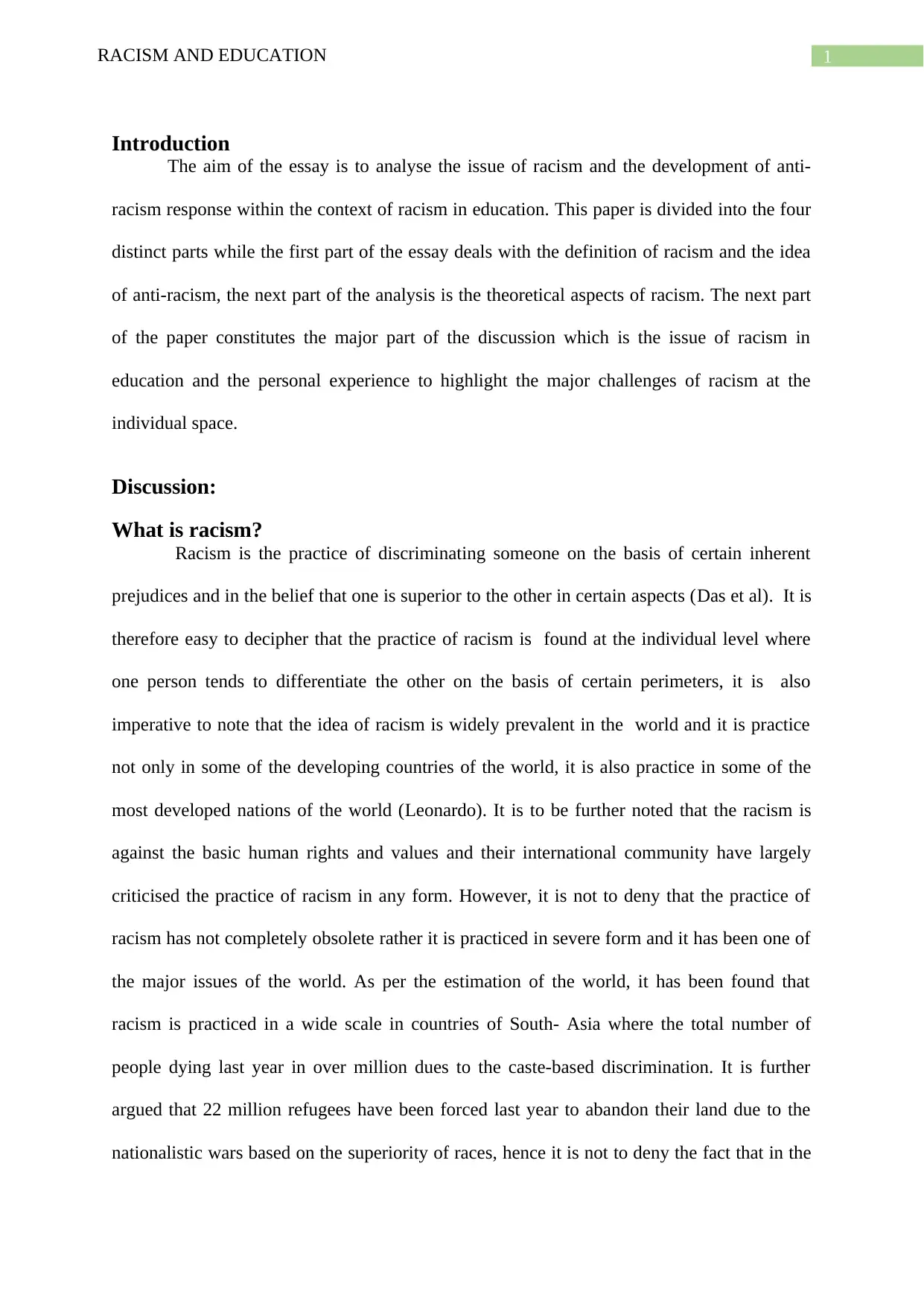
1RACISM AND EDUCATION
Introduction
The aim of the essay is to analyse the issue of racism and the development of anti-
racism response within the context of racism in education. This paper is divided into the four
distinct parts while the first part of the essay deals with the definition of racism and the idea
of anti-racism, the next part of the analysis is the theoretical aspects of racism. The next part
of the paper constitutes the major part of the discussion which is the issue of racism in
education and the personal experience to highlight the major challenges of racism at the
individual space.
Discussion:
What is racism?
Racism is the practice of discriminating someone on the basis of certain inherent
prejudices and in the belief that one is superior to the other in certain aspects (Das et al). It is
therefore easy to decipher that the practice of racism is found at the individual level where
one person tends to differentiate the other on the basis of certain perimeters, it is also
imperative to note that the idea of racism is widely prevalent in the world and it is practice
not only in some of the developing countries of the world, it is also practice in some of the
most developed nations of the world (Leonardo). It is to be further noted that the racism is
against the basic human rights and values and their international community have largely
criticised the practice of racism in any form. However, it is not to deny that the practice of
racism has not completely obsolete rather it is practiced in severe form and it has been one of
the major issues of the world. As per the estimation of the world, it has been found that
racism is practiced in a wide scale in countries of South- Asia where the total number of
people dying last year in over million dues to the caste-based discrimination. It is further
argued that 22 million refugees have been forced last year to abandon their land due to the
nationalistic wars based on the superiority of races, hence it is not to deny the fact that in the
Introduction
The aim of the essay is to analyse the issue of racism and the development of anti-
racism response within the context of racism in education. This paper is divided into the four
distinct parts while the first part of the essay deals with the definition of racism and the idea
of anti-racism, the next part of the analysis is the theoretical aspects of racism. The next part
of the paper constitutes the major part of the discussion which is the issue of racism in
education and the personal experience to highlight the major challenges of racism at the
individual space.
Discussion:
What is racism?
Racism is the practice of discriminating someone on the basis of certain inherent
prejudices and in the belief that one is superior to the other in certain aspects (Das et al). It is
therefore easy to decipher that the practice of racism is found at the individual level where
one person tends to differentiate the other on the basis of certain perimeters, it is also
imperative to note that the idea of racism is widely prevalent in the world and it is practice
not only in some of the developing countries of the world, it is also practice in some of the
most developed nations of the world (Leonardo). It is to be further noted that the racism is
against the basic human rights and values and their international community have largely
criticised the practice of racism in any form. However, it is not to deny that the practice of
racism has not completely obsolete rather it is practiced in severe form and it has been one of
the major issues of the world. As per the estimation of the world, it has been found that
racism is practiced in a wide scale in countries of South- Asia where the total number of
people dying last year in over million dues to the caste-based discrimination. It is further
argued that 22 million refugees have been forced last year to abandon their land due to the
nationalistic wars based on the superiority of races, hence it is not to deny the fact that in the
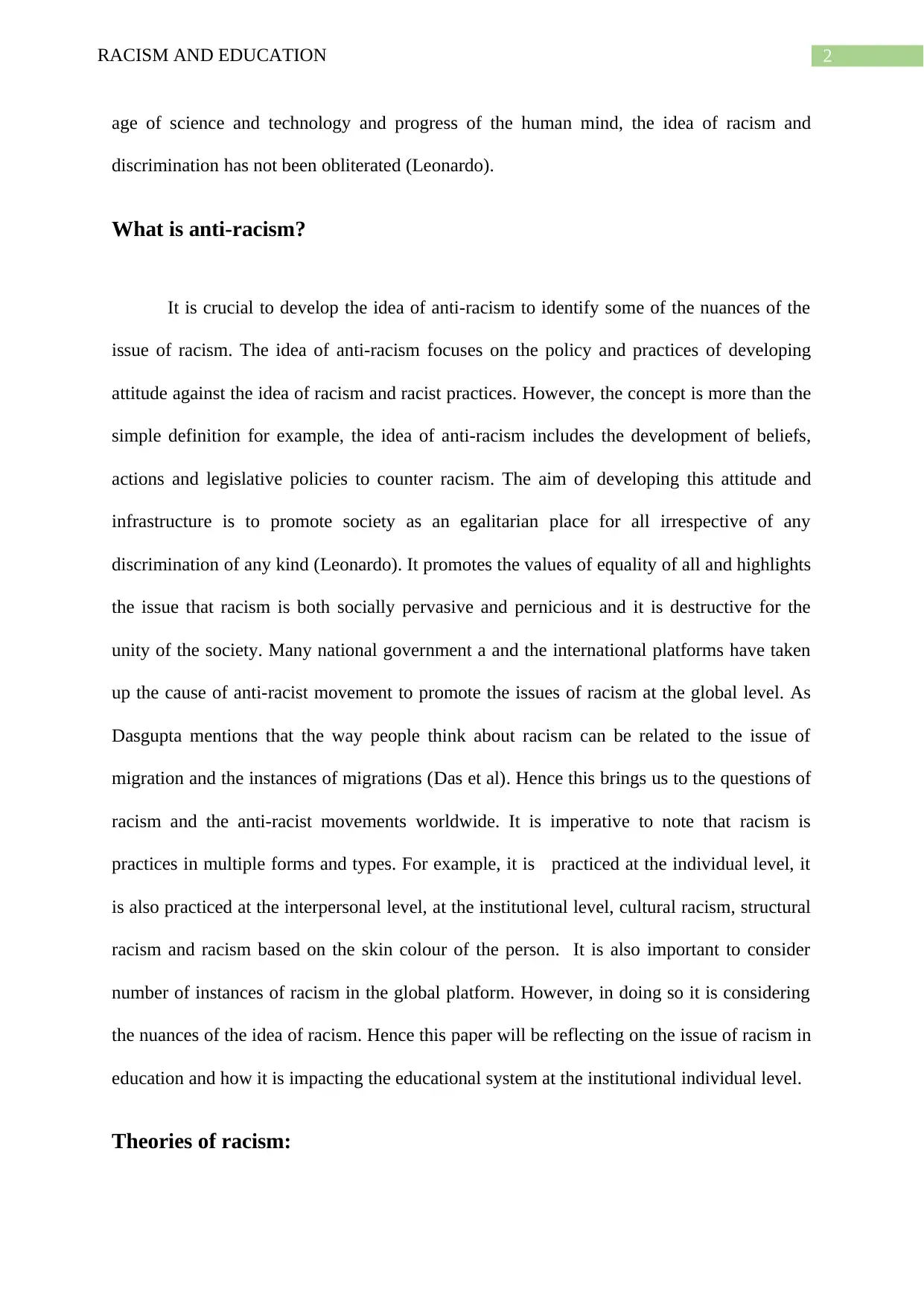
2RACISM AND EDUCATION
age of science and technology and progress of the human mind, the idea of racism and
discrimination has not been obliterated (Leonardo).
What is anti-racism?
It is crucial to develop the idea of anti-racism to identify some of the nuances of the
issue of racism. The idea of anti-racism focuses on the policy and practices of developing
attitude against the idea of racism and racist practices. However, the concept is more than the
simple definition for example, the idea of anti-racism includes the development of beliefs,
actions and legislative policies to counter racism. The aim of developing this attitude and
infrastructure is to promote society as an egalitarian place for all irrespective of any
discrimination of any kind (Leonardo). It promotes the values of equality of all and highlights
the issue that racism is both socially pervasive and pernicious and it is destructive for the
unity of the society. Many national government a and the international platforms have taken
up the cause of anti-racist movement to promote the issues of racism at the global level. As
Dasgupta mentions that the way people think about racism can be related to the issue of
migration and the instances of migrations (Das et al). Hence this brings us to the questions of
racism and the anti-racist movements worldwide. It is imperative to note that racism is
practices in multiple forms and types. For example, it is practiced at the individual level, it
is also practiced at the interpersonal level, at the institutional level, cultural racism, structural
racism and racism based on the skin colour of the person. It is also important to consider
number of instances of racism in the global platform. However, in doing so it is considering
the nuances of the idea of racism. Hence this paper will be reflecting on the issue of racism in
education and how it is impacting the educational system at the institutional individual level.
Theories of racism:
age of science and technology and progress of the human mind, the idea of racism and
discrimination has not been obliterated (Leonardo).
What is anti-racism?
It is crucial to develop the idea of anti-racism to identify some of the nuances of the
issue of racism. The idea of anti-racism focuses on the policy and practices of developing
attitude against the idea of racism and racist practices. However, the concept is more than the
simple definition for example, the idea of anti-racism includes the development of beliefs,
actions and legislative policies to counter racism. The aim of developing this attitude and
infrastructure is to promote society as an egalitarian place for all irrespective of any
discrimination of any kind (Leonardo). It promotes the values of equality of all and highlights
the issue that racism is both socially pervasive and pernicious and it is destructive for the
unity of the society. Many national government a and the international platforms have taken
up the cause of anti-racist movement to promote the issues of racism at the global level. As
Dasgupta mentions that the way people think about racism can be related to the issue of
migration and the instances of migrations (Das et al). Hence this brings us to the questions of
racism and the anti-racist movements worldwide. It is imperative to note that racism is
practices in multiple forms and types. For example, it is practiced at the individual level, it
is also practiced at the interpersonal level, at the institutional level, cultural racism, structural
racism and racism based on the skin colour of the person. It is also important to consider
number of instances of racism in the global platform. However, in doing so it is considering
the nuances of the idea of racism. Hence this paper will be reflecting on the issue of racism in
education and how it is impacting the educational system at the institutional individual level.
Theories of racism:
⊘ This is a preview!⊘
Do you want full access?
Subscribe today to unlock all pages.

Trusted by 1+ million students worldwide
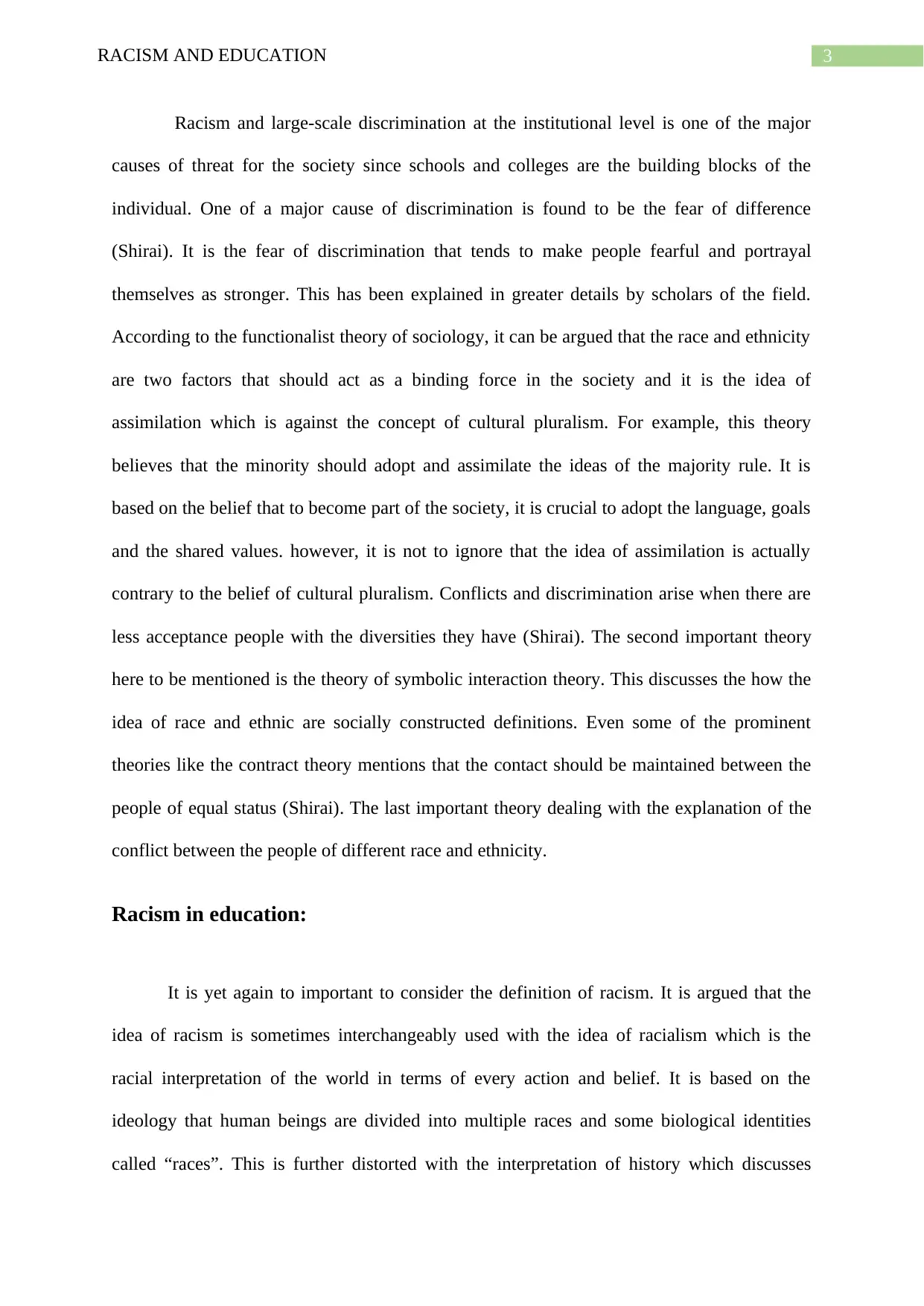
3RACISM AND EDUCATION
Racism and large-scale discrimination at the institutional level is one of the major
causes of threat for the society since schools and colleges are the building blocks of the
individual. One of a major cause of discrimination is found to be the fear of difference
(Shirai). It is the fear of discrimination that tends to make people fearful and portrayal
themselves as stronger. This has been explained in greater details by scholars of the field.
According to the functionalist theory of sociology, it can be argued that the race and ethnicity
are two factors that should act as a binding force in the society and it is the idea of
assimilation which is against the concept of cultural pluralism. For example, this theory
believes that the minority should adopt and assimilate the ideas of the majority rule. It is
based on the belief that to become part of the society, it is crucial to adopt the language, goals
and the shared values. however, it is not to ignore that the idea of assimilation is actually
contrary to the belief of cultural pluralism. Conflicts and discrimination arise when there are
less acceptance people with the diversities they have (Shirai). The second important theory
here to be mentioned is the theory of symbolic interaction theory. This discusses the how the
idea of race and ethnic are socially constructed definitions. Even some of the prominent
theories like the contract theory mentions that the contact should be maintained between the
people of equal status (Shirai). The last important theory dealing with the explanation of the
conflict between the people of different race and ethnicity.
Racism in education:
It is yet again to important to consider the definition of racism. It is argued that the
idea of racism is sometimes interchangeably used with the idea of racialism which is the
racial interpretation of the world in terms of every action and belief. It is based on the
ideology that human beings are divided into multiple races and some biological identities
called “races”. This is further distorted with the interpretation of history which discusses
Racism and large-scale discrimination at the institutional level is one of the major
causes of threat for the society since schools and colleges are the building blocks of the
individual. One of a major cause of discrimination is found to be the fear of difference
(Shirai). It is the fear of discrimination that tends to make people fearful and portrayal
themselves as stronger. This has been explained in greater details by scholars of the field.
According to the functionalist theory of sociology, it can be argued that the race and ethnicity
are two factors that should act as a binding force in the society and it is the idea of
assimilation which is against the concept of cultural pluralism. For example, this theory
believes that the minority should adopt and assimilate the ideas of the majority rule. It is
based on the belief that to become part of the society, it is crucial to adopt the language, goals
and the shared values. however, it is not to ignore that the idea of assimilation is actually
contrary to the belief of cultural pluralism. Conflicts and discrimination arise when there are
less acceptance people with the diversities they have (Shirai). The second important theory
here to be mentioned is the theory of symbolic interaction theory. This discusses the how the
idea of race and ethnic are socially constructed definitions. Even some of the prominent
theories like the contract theory mentions that the contact should be maintained between the
people of equal status (Shirai). The last important theory dealing with the explanation of the
conflict between the people of different race and ethnicity.
Racism in education:
It is yet again to important to consider the definition of racism. It is argued that the
idea of racism is sometimes interchangeably used with the idea of racialism which is the
racial interpretation of the world in terms of every action and belief. It is based on the
ideology that human beings are divided into multiple races and some biological identities
called “races”. This is further distorted with the interpretation of history which discusses
Paraphrase This Document
Need a fresh take? Get an instant paraphrase of this document with our AI Paraphraser
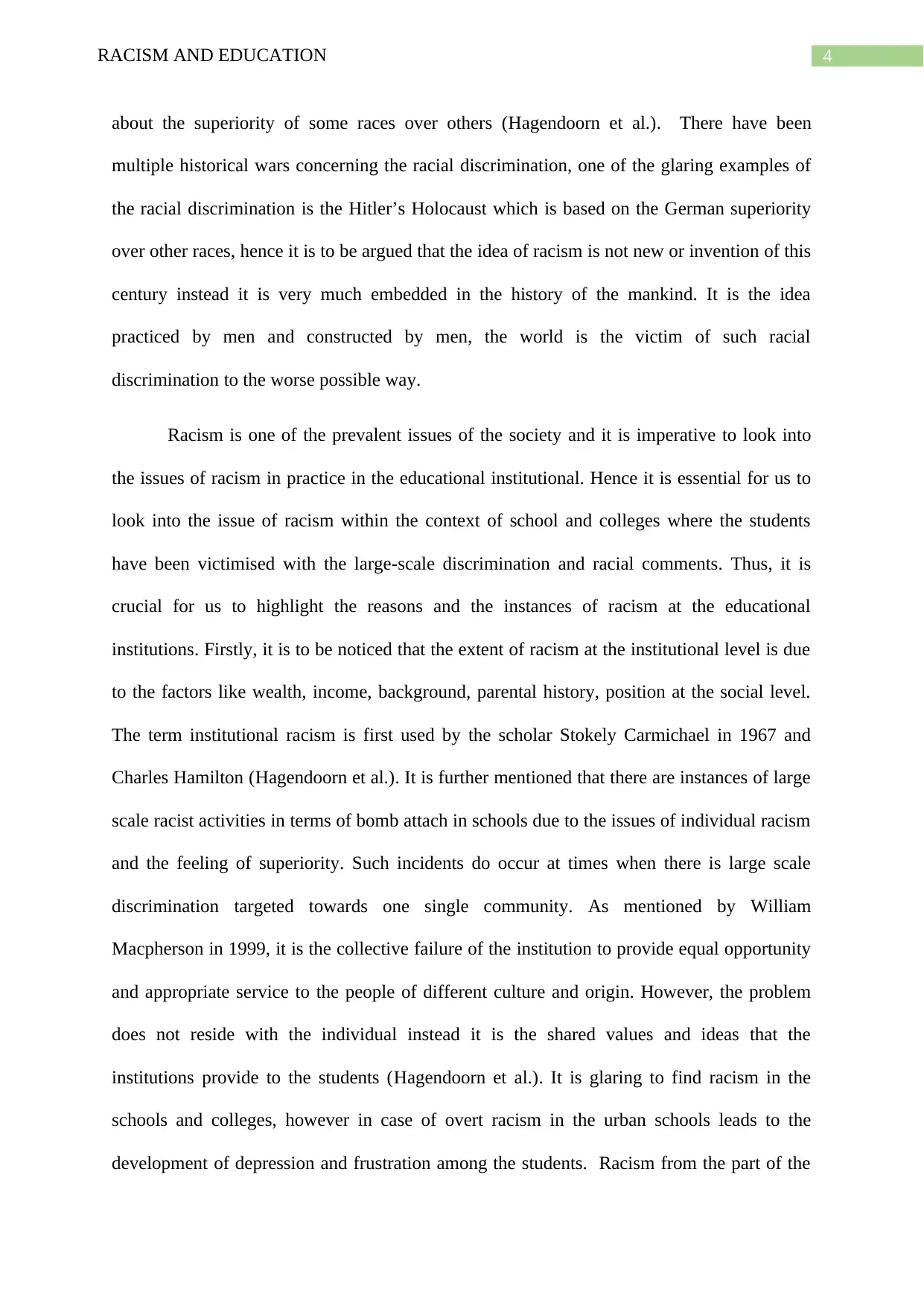
4RACISM AND EDUCATION
about the superiority of some races over others (Hagendoorn et al.). There have been
multiple historical wars concerning the racial discrimination, one of the glaring examples of
the racial discrimination is the Hitler’s Holocaust which is based on the German superiority
over other races, hence it is to be argued that the idea of racism is not new or invention of this
century instead it is very much embedded in the history of the mankind. It is the idea
practiced by men and constructed by men, the world is the victim of such racial
discrimination to the worse possible way.
Racism is one of the prevalent issues of the society and it is imperative to look into
the issues of racism in practice in the educational institutional. Hence it is essential for us to
look into the issue of racism within the context of school and colleges where the students
have been victimised with the large-scale discrimination and racial comments. Thus, it is
crucial for us to highlight the reasons and the instances of racism at the educational
institutions. Firstly, it is to be noticed that the extent of racism at the institutional level is due
to the factors like wealth, income, background, parental history, position at the social level.
The term institutional racism is first used by the scholar Stokely Carmichael in 1967 and
Charles Hamilton (Hagendoorn et al.). It is further mentioned that there are instances of large
scale racist activities in terms of bomb attach in schools due to the issues of individual racism
and the feeling of superiority. Such incidents do occur at times when there is large scale
discrimination targeted towards one single community. As mentioned by William
Macpherson in 1999, it is the collective failure of the institution to provide equal opportunity
and appropriate service to the people of different culture and origin. However, the problem
does not reside with the individual instead it is the shared values and ideas that the
institutions provide to the students (Hagendoorn et al.). It is glaring to find racism in the
schools and colleges, however in case of overt racism in the urban schools leads to the
development of depression and frustration among the students. Racism from the part of the
about the superiority of some races over others (Hagendoorn et al.). There have been
multiple historical wars concerning the racial discrimination, one of the glaring examples of
the racial discrimination is the Hitler’s Holocaust which is based on the German superiority
over other races, hence it is to be argued that the idea of racism is not new or invention of this
century instead it is very much embedded in the history of the mankind. It is the idea
practiced by men and constructed by men, the world is the victim of such racial
discrimination to the worse possible way.
Racism is one of the prevalent issues of the society and it is imperative to look into
the issues of racism in practice in the educational institutional. Hence it is essential for us to
look into the issue of racism within the context of school and colleges where the students
have been victimised with the large-scale discrimination and racial comments. Thus, it is
crucial for us to highlight the reasons and the instances of racism at the educational
institutions. Firstly, it is to be noticed that the extent of racism at the institutional level is due
to the factors like wealth, income, background, parental history, position at the social level.
The term institutional racism is first used by the scholar Stokely Carmichael in 1967 and
Charles Hamilton (Hagendoorn et al.). It is further mentioned that there are instances of large
scale racist activities in terms of bomb attach in schools due to the issues of individual racism
and the feeling of superiority. Such incidents do occur at times when there is large scale
discrimination targeted towards one single community. As mentioned by William
Macpherson in 1999, it is the collective failure of the institution to provide equal opportunity
and appropriate service to the people of different culture and origin. However, the problem
does not reside with the individual instead it is the shared values and ideas that the
institutions provide to the students (Hagendoorn et al.). It is glaring to find racism in the
schools and colleges, however in case of overt racism in the urban schools leads to the
development of depression and frustration among the students. Racism from the part of the
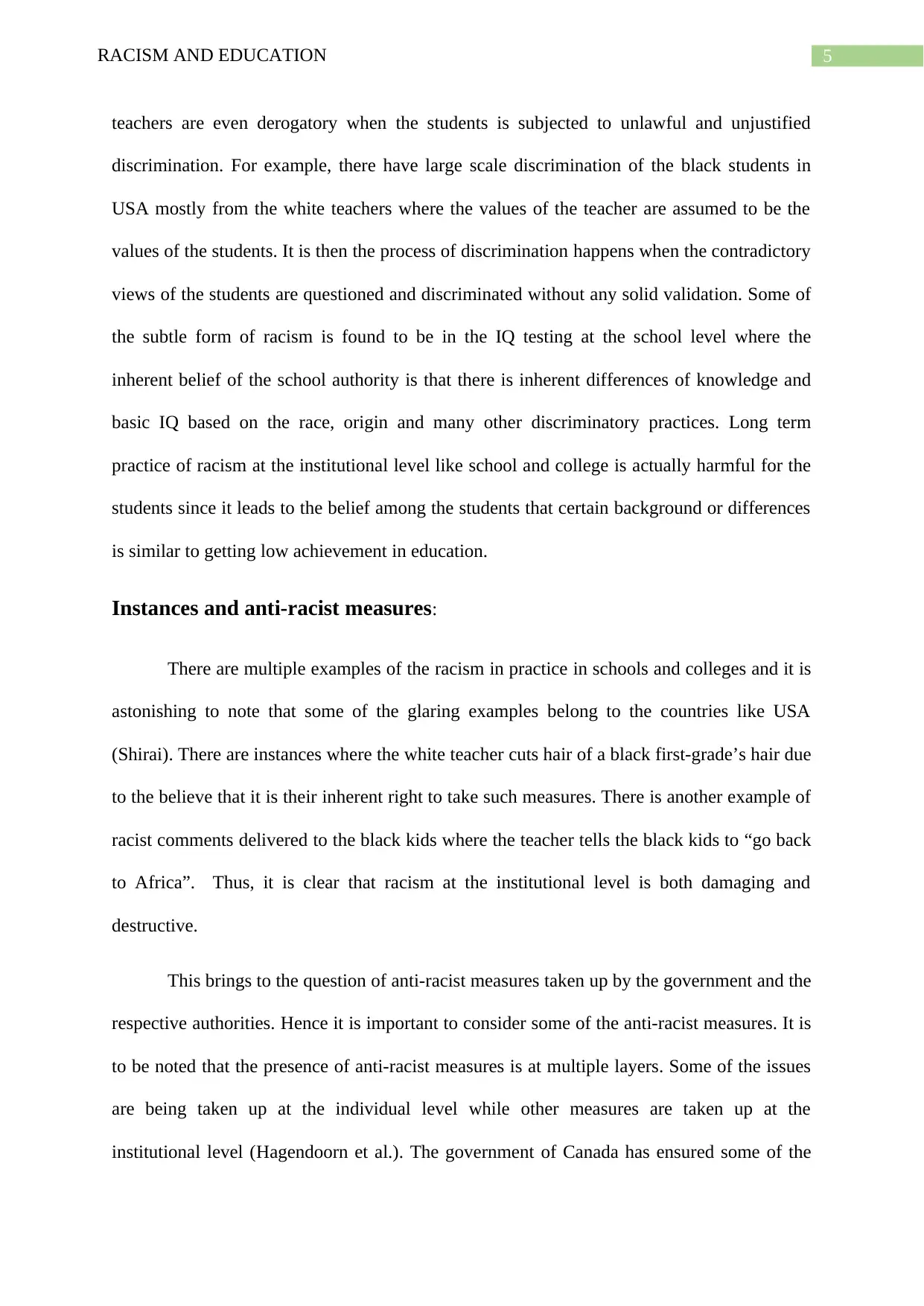
5RACISM AND EDUCATION
teachers are even derogatory when the students is subjected to unlawful and unjustified
discrimination. For example, there have large scale discrimination of the black students in
USA mostly from the white teachers where the values of the teacher are assumed to be the
values of the students. It is then the process of discrimination happens when the contradictory
views of the students are questioned and discriminated without any solid validation. Some of
the subtle form of racism is found to be in the IQ testing at the school level where the
inherent belief of the school authority is that there is inherent differences of knowledge and
basic IQ based on the race, origin and many other discriminatory practices. Long term
practice of racism at the institutional level like school and college is actually harmful for the
students since it leads to the belief among the students that certain background or differences
is similar to getting low achievement in education.
Instances and anti-racist measures:
There are multiple examples of the racism in practice in schools and colleges and it is
astonishing to note that some of the glaring examples belong to the countries like USA
(Shirai). There are instances where the white teacher cuts hair of a black first-grade’s hair due
to the believe that it is their inherent right to take such measures. There is another example of
racist comments delivered to the black kids where the teacher tells the black kids to “go back
to Africa”. Thus, it is clear that racism at the institutional level is both damaging and
destructive.
This brings to the question of anti-racist measures taken up by the government and the
respective authorities. Hence it is important to consider some of the anti-racist measures. It is
to be noted that the presence of anti-racist measures is at multiple layers. Some of the issues
are being taken up at the individual level while other measures are taken up at the
institutional level (Hagendoorn et al.). The government of Canada has ensured some of the
teachers are even derogatory when the students is subjected to unlawful and unjustified
discrimination. For example, there have large scale discrimination of the black students in
USA mostly from the white teachers where the values of the teacher are assumed to be the
values of the students. It is then the process of discrimination happens when the contradictory
views of the students are questioned and discriminated without any solid validation. Some of
the subtle form of racism is found to be in the IQ testing at the school level where the
inherent belief of the school authority is that there is inherent differences of knowledge and
basic IQ based on the race, origin and many other discriminatory practices. Long term
practice of racism at the institutional level like school and college is actually harmful for the
students since it leads to the belief among the students that certain background or differences
is similar to getting low achievement in education.
Instances and anti-racist measures:
There are multiple examples of the racism in practice in schools and colleges and it is
astonishing to note that some of the glaring examples belong to the countries like USA
(Shirai). There are instances where the white teacher cuts hair of a black first-grade’s hair due
to the believe that it is their inherent right to take such measures. There is another example of
racist comments delivered to the black kids where the teacher tells the black kids to “go back
to Africa”. Thus, it is clear that racism at the institutional level is both damaging and
destructive.
This brings to the question of anti-racist measures taken up by the government and the
respective authorities. Hence it is important to consider some of the anti-racist measures. It is
to be noted that the presence of anti-racist measures is at multiple layers. Some of the issues
are being taken up at the individual level while other measures are taken up at the
institutional level (Hagendoorn et al.). The government of Canada has ensured some of the
⊘ This is a preview!⊘
Do you want full access?
Subscribe today to unlock all pages.

Trusted by 1+ million students worldwide
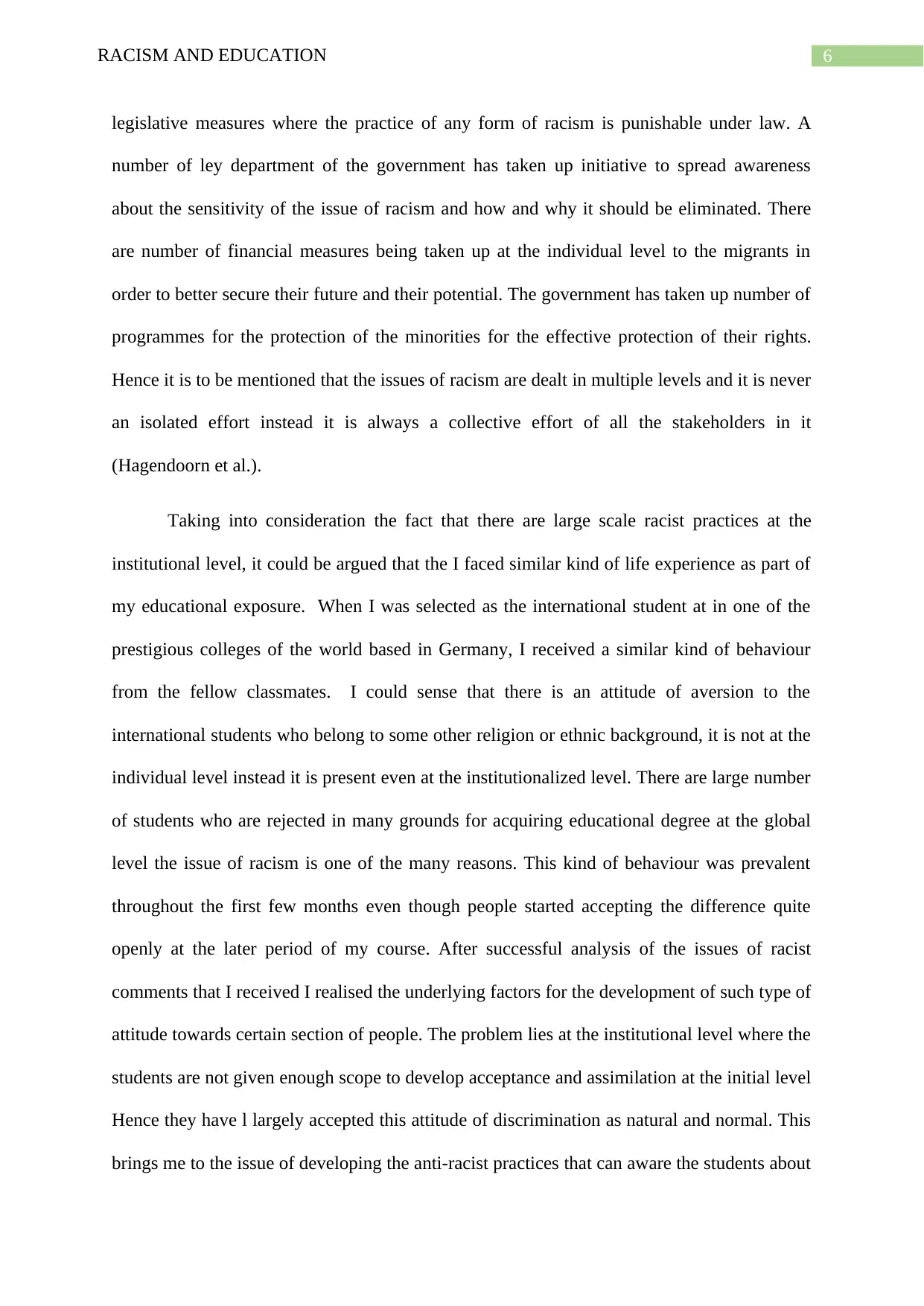
6RACISM AND EDUCATION
legislative measures where the practice of any form of racism is punishable under law. A
number of ley department of the government has taken up initiative to spread awareness
about the sensitivity of the issue of racism and how and why it should be eliminated. There
are number of financial measures being taken up at the individual level to the migrants in
order to better secure their future and their potential. The government has taken up number of
programmes for the protection of the minorities for the effective protection of their rights.
Hence it is to be mentioned that the issues of racism are dealt in multiple levels and it is never
an isolated effort instead it is always a collective effort of all the stakeholders in it
(Hagendoorn et al.).
Taking into consideration the fact that there are large scale racist practices at the
institutional level, it could be argued that the I faced similar kind of life experience as part of
my educational exposure. When I was selected as the international student at in one of the
prestigious colleges of the world based in Germany, I received a similar kind of behaviour
from the fellow classmates. I could sense that there is an attitude of aversion to the
international students who belong to some other religion or ethnic background, it is not at the
individual level instead it is present even at the institutionalized level. There are large number
of students who are rejected in many grounds for acquiring educational degree at the global
level the issue of racism is one of the many reasons. This kind of behaviour was prevalent
throughout the first few months even though people started accepting the difference quite
openly at the later period of my course. After successful analysis of the issues of racist
comments that I received I realised the underlying factors for the development of such type of
attitude towards certain section of people. The problem lies at the institutional level where the
students are not given enough scope to develop acceptance and assimilation at the initial level
Hence they have l largely accepted this attitude of discrimination as natural and normal. This
brings me to the issue of developing the anti-racist practices that can aware the students about
legislative measures where the practice of any form of racism is punishable under law. A
number of ley department of the government has taken up initiative to spread awareness
about the sensitivity of the issue of racism and how and why it should be eliminated. There
are number of financial measures being taken up at the individual level to the migrants in
order to better secure their future and their potential. The government has taken up number of
programmes for the protection of the minorities for the effective protection of their rights.
Hence it is to be mentioned that the issues of racism are dealt in multiple levels and it is never
an isolated effort instead it is always a collective effort of all the stakeholders in it
(Hagendoorn et al.).
Taking into consideration the fact that there are large scale racist practices at the
institutional level, it could be argued that the I faced similar kind of life experience as part of
my educational exposure. When I was selected as the international student at in one of the
prestigious colleges of the world based in Germany, I received a similar kind of behaviour
from the fellow classmates. I could sense that there is an attitude of aversion to the
international students who belong to some other religion or ethnic background, it is not at the
individual level instead it is present even at the institutionalized level. There are large number
of students who are rejected in many grounds for acquiring educational degree at the global
level the issue of racism is one of the many reasons. This kind of behaviour was prevalent
throughout the first few months even though people started accepting the difference quite
openly at the later period of my course. After successful analysis of the issues of racist
comments that I received I realised the underlying factors for the development of such type of
attitude towards certain section of people. The problem lies at the institutional level where the
students are not given enough scope to develop acceptance and assimilation at the initial level
Hence they have l largely accepted this attitude of discrimination as natural and normal. This
brings me to the issue of developing the anti-racist practices that can aware the students about
Paraphrase This Document
Need a fresh take? Get an instant paraphrase of this document with our AI Paraphraser
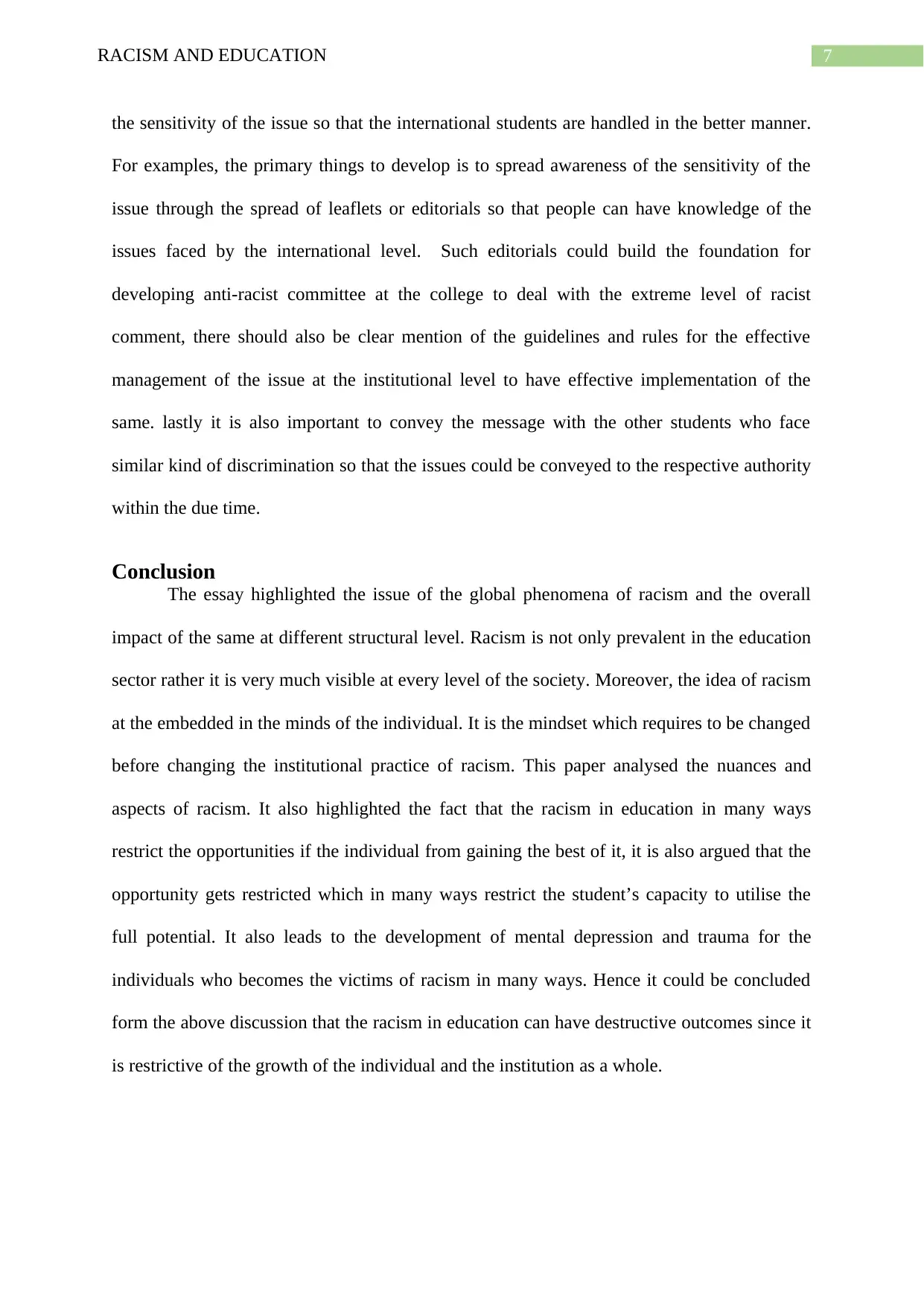
7RACISM AND EDUCATION
the sensitivity of the issue so that the international students are handled in the better manner.
For examples, the primary things to develop is to spread awareness of the sensitivity of the
issue through the spread of leaflets or editorials so that people can have knowledge of the
issues faced by the international level. Such editorials could build the foundation for
developing anti-racist committee at the college to deal with the extreme level of racist
comment, there should also be clear mention of the guidelines and rules for the effective
management of the issue at the institutional level to have effective implementation of the
same. lastly it is also important to convey the message with the other students who face
similar kind of discrimination so that the issues could be conveyed to the respective authority
within the due time.
Conclusion
The essay highlighted the issue of the global phenomena of racism and the overall
impact of the same at different structural level. Racism is not only prevalent in the education
sector rather it is very much visible at every level of the society. Moreover, the idea of racism
at the embedded in the minds of the individual. It is the mindset which requires to be changed
before changing the institutional practice of racism. This paper analysed the nuances and
aspects of racism. It also highlighted the fact that the racism in education in many ways
restrict the opportunities if the individual from gaining the best of it, it is also argued that the
opportunity gets restricted which in many ways restrict the student’s capacity to utilise the
full potential. It also leads to the development of mental depression and trauma for the
individuals who becomes the victims of racism in many ways. Hence it could be concluded
form the above discussion that the racism in education can have destructive outcomes since it
is restrictive of the growth of the individual and the institution as a whole.
the sensitivity of the issue so that the international students are handled in the better manner.
For examples, the primary things to develop is to spread awareness of the sensitivity of the
issue through the spread of leaflets or editorials so that people can have knowledge of the
issues faced by the international level. Such editorials could build the foundation for
developing anti-racist committee at the college to deal with the extreme level of racist
comment, there should also be clear mention of the guidelines and rules for the effective
management of the issue at the institutional level to have effective implementation of the
same. lastly it is also important to convey the message with the other students who face
similar kind of discrimination so that the issues could be conveyed to the respective authority
within the due time.
Conclusion
The essay highlighted the issue of the global phenomena of racism and the overall
impact of the same at different structural level. Racism is not only prevalent in the education
sector rather it is very much visible at every level of the society. Moreover, the idea of racism
at the embedded in the minds of the individual. It is the mindset which requires to be changed
before changing the institutional practice of racism. This paper analysed the nuances and
aspects of racism. It also highlighted the fact that the racism in education in many ways
restrict the opportunities if the individual from gaining the best of it, it is also argued that the
opportunity gets restricted which in many ways restrict the student’s capacity to utilise the
full potential. It also leads to the development of mental depression and trauma for the
individuals who becomes the victims of racism in many ways. Hence it could be concluded
form the above discussion that the racism in education can have destructive outcomes since it
is restrictive of the growth of the individual and the institution as a whole.
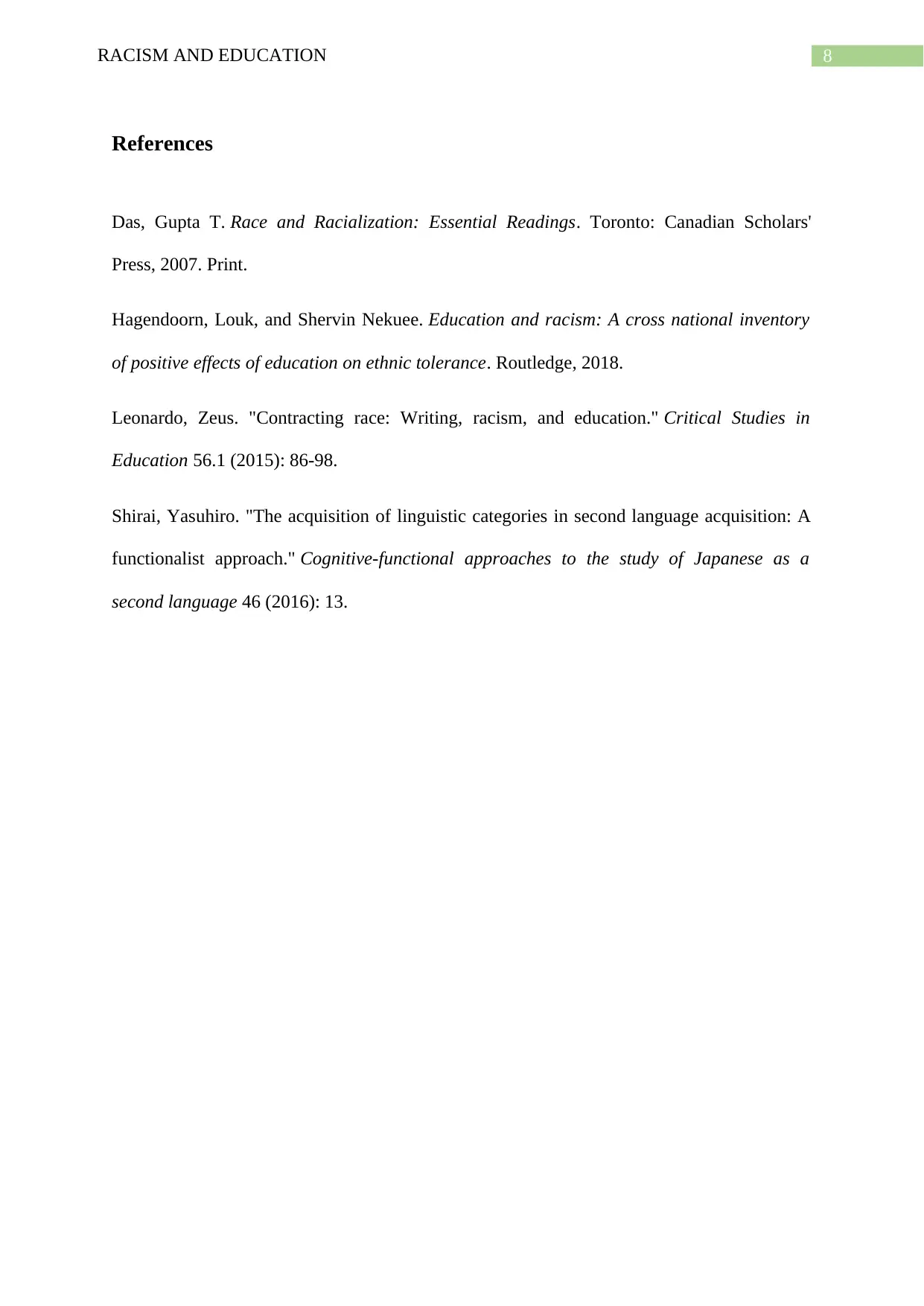
8RACISM AND EDUCATION
References
Das, Gupta T. Race and Racialization: Essential Readings. Toronto: Canadian Scholars'
Press, 2007. Print.
Hagendoorn, Louk, and Shervin Nekuee. Education and racism: A cross national inventory
of positive effects of education on ethnic tolerance. Routledge, 2018.
Leonardo, Zeus. "Contracting race: Writing, racism, and education." Critical Studies in
Education 56.1 (2015): 86-98.
Shirai, Yasuhiro. "The acquisition of linguistic categories in second language acquisition: A
functionalist approach." Cognitive-functional approaches to the study of Japanese as a
second language 46 (2016): 13.
References
Das, Gupta T. Race and Racialization: Essential Readings. Toronto: Canadian Scholars'
Press, 2007. Print.
Hagendoorn, Louk, and Shervin Nekuee. Education and racism: A cross national inventory
of positive effects of education on ethnic tolerance. Routledge, 2018.
Leonardo, Zeus. "Contracting race: Writing, racism, and education." Critical Studies in
Education 56.1 (2015): 86-98.
Shirai, Yasuhiro. "The acquisition of linguistic categories in second language acquisition: A
functionalist approach." Cognitive-functional approaches to the study of Japanese as a
second language 46 (2016): 13.
⊘ This is a preview!⊘
Do you want full access?
Subscribe today to unlock all pages.

Trusted by 1+ million students worldwide
1 out of 9
Related Documents
Your All-in-One AI-Powered Toolkit for Academic Success.
+13062052269
info@desklib.com
Available 24*7 on WhatsApp / Email
![[object Object]](/_next/static/media/star-bottom.7253800d.svg)
Unlock your academic potential
Copyright © 2020–2025 A2Z Services. All Rights Reserved. Developed and managed by ZUCOL.





